|
|
|
Sort Order |
|
|
|
Items / Page
|
|
|
|
|
|
|
| Srl | Item |
| 1 |
ID:
072085
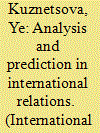

|
|
|
| 2 |
ID:
114041
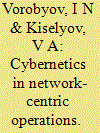

|
|
|
|
|
| Publication |
2012.
|
| Summary/Abstract |
The authors look at the role of cybernetics as a science of mathematical philosophy applicable to general laws of control in a system of network-centric operations and make pioneering attempts to formulate its principles and offer recommendations to put them into effect by commanders and staffs.
|
|
|
|
|
|
|
|
|
|
|
|
|
|
|
|
| 3 |
ID:
105940
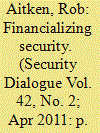

|
|
|
|
|
| Publication |
2011.
|
| Summary/Abstract |
The logics of 'finance' and 'security' have been enmeshed within each other in complicated ways since at least the start of the 20th century. As fields deeply alive to the possibilities and dangers associated with risk and uncertainty, finance and security occupy overlapping but uneven fields of operation. This article examines one particular financial mechanism - political prediction markets - in order to trace out the tensions and intersections of finance and security in one particular site. Political prediction markets are designed to harness the predictive power of the market to address an inherently uncertain object - the weather, political events, terrorism, etc. A series of recent cases - most notoriously a proposal by the Pentagon to construct a 'terrorism futures market' - have sought to recast political prediction markets as a security practice and to enlist these markets in the ongoing 'war on terror'. This article argues that these attempts at financializing security offer a particularly useful glimpse into one point of overlap between security and finance. As markets constructed to measure and manage uncertainty, experiments in security prediction markets foreclose political space not only as a ritual of securitization that places certain issues above or beyond political deliberation but also as a reinvocation of a conception of 'finance' as a somehow rational and technical domain. As the terrorism futures case reminds us, however, the rational ambitions associated with these two governmentalities of financialization and securitization can become corroded or can lose coherence in unpredictable ways. It is in the political tension that is generated through such corrosions that the future of these kinds of experiments in the financialization of security will ultimately be decided.
|
|
|
|
|
|
|
|
|
|
|
|
|
|
|
|
| 4 |
ID:
152293
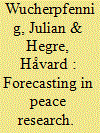

|
|
|
|
|
| Summary/Abstract |
Prediction and forecasting have now fully reached peace and conflict research. We define forecasting as predictions about unrealized outcomes given model estimates from realized data, and predictions more generally as the assignment of probability distributions to realized or unrealized outcomes. Increasingly, scholars present within- and out-of-sample prediction results in their publications and sometimes even forecasts for unrealized, future outcomes. The articles in this special issue demonstrate the ability of current approaches to forecast events of interest and contributes to the formulation of best practices for forecasting within peace research. We highlight the role of forecasting for theory evaluation and as a bridge between academics and policymakers, summarize the contributions in the special issue, and provide some thoughts on how research on forecasting in peace research should proceed. We suggest some best practices, noting the importance of theory development, interpretability of models, replicability of results, and data collection.
|
|
|
|
|
|
|
|
|
|
|
|
|
|
|
|
| 5 |
ID:
121787
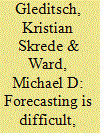

|
|
|
|
|
| Publication |
2013.
|
| Summary/Abstract |
Prediction is an important goal in the study of international conflict, but a large body of research has found that existing statistical models generally have disappointing predictive abilities. We show that most efforts build on models unlikely to be helpful for prediction. Many models essentially ignore the origins of conflict; studies look either at invariant structural features believed to affect the opportunities of conflict, or at factors that are believed to reduce the baseline risk of conflict, without attempting to identify the potential motivations and contentious issues over which conflicts typically arise. Researchers that have considered how contentious issues may motivate conflict and how these can be managed, using the Issues Correlates of War (ICOW) data, have not considered how these features may inform prediction. We assess the risk of dyadic interstate conflict based on the presence of specific contentious issues and conflict management events that may change the conflict potential of these contentious issues. We evaluate to what extent incorporating contentious issues and conflict management can help improve out-of-sample forecasting, as well as advance our understanding of conflict dynamics. Our results provide strong support for the idea that taking into account contentious issues can inform and improve out-of-sample forecasting.
|
|
|
|
|
|
|
|
|
|
|
|
|
|
|
|
| 6 |
ID:
128854
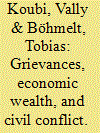

|
|
|
|
|
| Publication |
2014.
|
| Summary/Abstract |
One of the most robust findings in the literature on civil conflicts is that high income levels are associated with a lower risk of conflict onset. This article addresses the wealth-conflict link and discusses it in relation to the dominating `greed vs. grievance' dichotomy. It is further argued that the effect on conflict of grievances, in the form of horizontal inequalities, is conditioned on national wealth. More specifically, there may be a higher risk of civil war in those countries that have much wealth, but where a large share of the population is potentially excluded from accessing it. The empirical analyses testing this argument employ time-series cross-section data for 1951-2004 and find support for the theory. The authors also show that taking this conditional relationship into account improves our ability to predict the onset of civil conflict.
|
|
|
|
|
|
|
|
|
|
|
|
|
|
|
|
| 7 |
ID:
152295
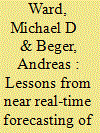

|
|
|
|
|
| Summary/Abstract |
Since 2014, we have been producing regular six-month forecasts of the probability of irregular leadership changes – coups, rebellions, protests that result in state leader changes – for most countries in the world for the Political Instability Task Force (PITF). During 2015, we issued new forecasts each month, with a delay as short as five days and no longer than two weeks into each six-month forecasting window. This article describes the approach we use to generate our forecasts and presents several examples of how we present forecasts. The forecasts are derived from a statistical ensemble of seven thematic models, each based on a split-population duration model that aims to capture a specific argument or related set of covariates. This approach is modular in that thematic models can be swapped out or new models integrated, and it lessens the need for generalist ‘kitchen sink’ models. Together, the models achieve high out-of-sample accuracy. Based on our experience, we draw conclusions about the practical, policy, and scientific aspects of this and similar undertakings. These include thoughts on how to evaluate and present forecasts, the potential role of ensembles in model comparison, the role of ensembles and prediction in causal research, and considerations for future efforts in forecasting and predictive modeling.
|
|
|
|
|
|
|
|
|
|
|
|
|
|
|
|
| 8 |
ID:
152300
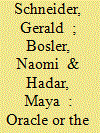

|
|
|
|
|
| Summary/Abstract |
The forecasting literature has come to mistrust the predictions made by experts who forecast political events in mass media. Distinguishing between judgements made by one or few individuals (‘oracles’) and assessments made by larger groups (‘crowds’), we contrast journalistic predictions with forecasts stemming from the financial industry. These two competing views were evaluated in a quantitative analysis of the ex ante success of 24 ceasefire agreements in various conflicts which took place in the Levant from 1993 to 2014. Our analysis compares the forecasts appearing in press commentaries (Haaretz, Jerusalem Post and New York Times) with the expectations that the Tel Aviv Stock Exchange had about the stability of these cooperative efforts. To evaluate the predictions of these very dissimilar sources, the effectiveness of the ceasefires was analysed through the number of violent events following the official start of the truce. The analysis shows that the financial industry performs better than the media industry in the comparative evaluation of ceasefire forecasts, but that neither source provides sufficiently accurate predictions. The partial support for the crowd thesis is discussed in light of recent literature that resuscitates the usage of well-trained experts for forecasting purposes, but warns against the dramatizing predictions of media pundits.
|
|
|
|
|
|
|
|
|
|
|
|
|
|
|
|
| 9 |
ID:
098408


|
|
|
|
|
| Publication |
2010.
|
| Summary/Abstract |
Large-n studies of conflict have produced a large number of statistically significant results but little accurate guidance in terms of anticipating the onset of conflict. The authors argue that too much attention has been paid to finding statistically significant relationships, while too little attention has been paid to finding variables that improve our ability to predict civil wars. The result can be a distorted view of what matters most to the onset of conflict. Although these models may not be intended to be predictive models, prescriptions based on these models are generally based on statistical significance, and the predictive attributes of the underlying models are generally ignored. These predictions should not be ignored, but rather need to be heuristically evaluated because they may shed light on the veracity of the models. In this study, the authors conduct a side-by-side comparison of the statistical significance and predictive power of the different variables used in two of the most influential models of civil war. The results provide a clear demonstration of how potentially misleading the traditional focus on statistical significance can be. Until out-of-sample heuristics - especially including predictions - are part of the normal evaluative tools in conflict research, we are unlikely to make sufficient theoretical progress beyond broad statements that point to GDP per capita and population as the major causal factors accounting for civil war onset.
|
|
|
|
|
|
|
|
|
|
|
|
|
|
|
|
| 10 |
ID:
159504
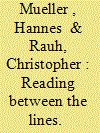

|
|
|
|
|
| Summary/Abstract |
This article provides a new methodology to predict armed conflict by using newspaper text. Through machine learning, vast quantities of newspaper text are reduced to interpretable topics. These topics are then used in panel regressions to predict the onset of conflict. We propose the use of the within-country variation of these topics to predict the timing of conflict. This allows us to avoid the tendency of predicting conflict only in countries where it occurred before. We show that the within-country variation of topics is a good predictor of conflict and becomes particularly useful when risk in previously peaceful countries arises. Two aspects seem to be responsible for these features. Topics provide depth because they consist of changing, long lists of terms that make them able to capture the changing context of conflict. At the same time, topics provide width because they are summaries of the full text, including stabilizing factors.
|
|
|
|
|
|
|
|
|
|
|
|
|
|
|
|
| 11 |
ID:
089322
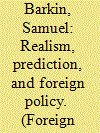

|
|
|
|
|
| Publication |
2009.
|
| Summary/Abstract |
Attempts by some contemporary realists to both claim that international politics are objectively predictable and at the same time prescribe particular foreign policies cannot hold together logically, because they are internally contradictory. The core argument of this article is that these attempts not only fail to fulfill their goal, but that the attempt to be scientific, to see the world as predictable, is ontologically incompatible with the core insight of classical realism, that we must see the world as it is, rather than as we want it to be. There are two ramifications of this observation for a realism that is not internally contradictory. The first is that a prescriptive realism must be a theory of foreign policy, not a theory of systems structure. And the second is that a realism that works as a theory of foreign policy prediction needs to be reflexive, needs to examine its own assumptions and biases as an integral part of the process of studying international politics.
|
|
|
|
|
|
|
|
|
|
|
|
|
|
|
|
| 12 |
ID:
180673


|
|
|
|
|
| Summary/Abstract |
We examine the research protocols in Blair and Sambanis’ recent article on forecasting civil wars, where they argue that their theory-based model can predict civil war onsets better than several atheoretical alternatives or a model with country-structural factors. We find that there are several important mistakes and that their key finding is entirely conditional on the use of parametrically smoothed ROC curves when calculating accuracy, rather than the standard empirical ROC curves that dominate the literature. Fixing these mistakes results in a reversal of their claim that theory-based models of escalation are better at predicting onsets of civil war than other kinds of models. Their model is outperformed by several of the ad hoc, putatively non-theoretical models they devise and examine. More importantly, we argue that rather than trying to contrast the roles of theory and “atheoretical” machine learning in predictive modeling, it would be more productive to focus on ways in which predictive modeling and machine learning could be used to strengthen extant predictive work. Instead, we argue that predictive modeling and machine learning are effective tools for theory testing.
|
|
|
|
|
|
|
|
|
|
|
|
|
|
|
|
| 13 |
ID:
152303


|
|
|
|
|
| Summary/Abstract |
We examine if dynamic information from event data can help improve on a model attempting to forecast civil war using measures reflecting plausible motivation and grievances. Buhaug, Cederman, and Gleditsch predict the risk of civil war using a horizontal inequality model with measures reflecting motivation and relevant group characteristics at the country level. The predictions from their model outperform in an out-of-sample forecast conventional country-level models of civil war, emphasizing vertical inequality and country characteristics. However, most grievance measures change little over time. We surmise that a model reflecting potential motivation for conflict can be improved with more dynamic information on mobilization and the behavior of actors. Our conjecture receives some support in the empirical analysis, where we consider both conflict onset and termination over territorial and governmental incompatibilities in the Uppsala/PRIO Armed Conflict Data, and find some evidence that event data can help improve forecasts. Moreover, models with the original grievance measures do better than purely event based models, supporting our claim that both structure and event based components can add value to conflict prediction models. However, the contribution of events to improving predictive power is modest and not entirely consistent, and some types of conflict events seem easier to forecast than others.
|
|
|
|
|
|
|
|
|
|
|
|
|
|
|
|
| 14 |
ID:
149331
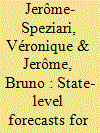

|
|
|
| 15 |
ID:
134897
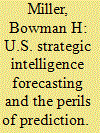

|
|
|
|
|
| Summary/Abstract |
Prediction, even of tomorrow's weather, remains a decidedly inexact science, but forecasting strategic geo-political or economic change is vastly more challenging. The Old Farmers’ Almanac has been in continuous publication in the United States since 1792, predicting long-term weather patterns and phases of the moon, among other things. But in 1942 the U.S. government sought to ban its publication after a German spy with a copy of the Almanac was apprehended. Suspicions centered on what the German might have found of intelligence value in this household volume, with special concern focused on “weather forecasts.” Confronted with a potential wartime ban on its publication, the Almanac relabeled that section “weather indications,” and the threatened ban was vacated. 2 The Almanac's “prediction” had nothing to do with warfare and everything to do with when to plant crops and gardens.
|
|
|
|
|
|
|
|
|
|
|
|
|
|
|
|
|
|
|
|
|